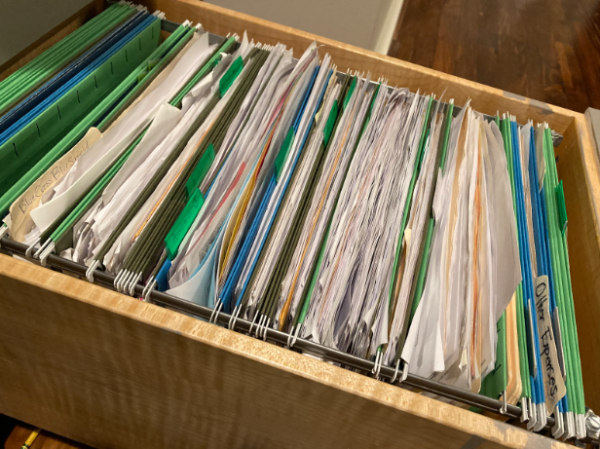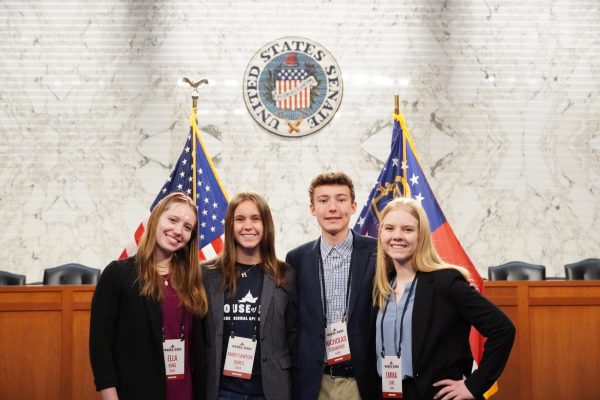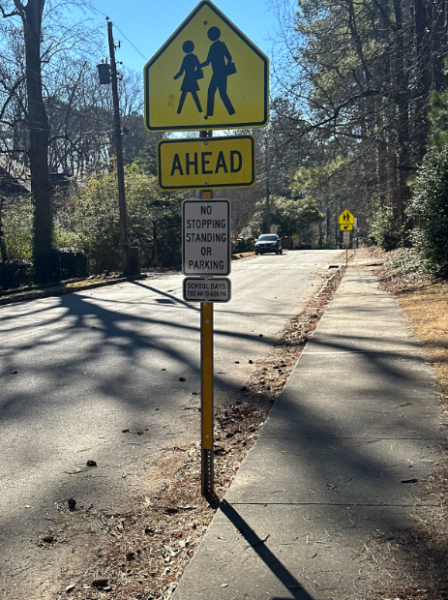Virtually Freshmen: Chamblee Newcomers React to Digital Start
As school goes virtual, many freshmen are finding that their high school transition is not what they thought it would be.
Freshman year of high school is often known as a milestone in any teenager’s life, marking one’s transformation from a nervous and confused middle schooler to a cool and confident high schooler.
Unfortunately, with the sudden introduction of virtual learning because of the COVID-19 pandemic, Chamblee’s class of 2024 has had a rather shaky start to their freshman year as they learn the ins and outs of high school from behind a computer screen.
Virtual Socialization
For freshman Liliana Sandfort, virtual learning has relieved some of her apprehensions about starting high school.
“I think it’s definitely different because I was, to be honest, a little scared to start high school as a freshman because there’s just a bunch of people who I don’t know and who are older than me,” said Sandfort. “But now it’s just not like that.”
Although Sandfort is relieved that she does not have to mingle with a new crowd, freshman Peirong Gao is a bit disappointed that she is missing out on meeting new people.
“I feel like it’s definitely harder to meet new people, especially upperclassmen, since we’re all online,” said Gao. “I’ve joined some clubs, but you just have these chats and google classrooms for different clubs. There’s been some interest meetings where you’ve gotten to see some new people, but you don’t really get to interact with them that much.”
Freshman Paul Frilingos also agrees that virtual learning has interfered with his ability to connect with his peers, making for mundane school days.
“The fun part of school is being able to see the people,” said Frilingos. “Now we have all of school except the fun part.”
Restricted socialization with new classmates definitely has freshmen unhappy, but not for all the same reasons. Some new students, like freshman Hannah Choy, came into Chamblee with a limited friend group and are now unable to make friends virtually, furthering the social divide between freshmen from feeder middle schools and freshmen new to Chamblee.
“I didn’t actually go to Chamblee Middle School so I don’t really know a lot of people,” said Choy. “It’s definitely been very unusual because […] I can’t really ask people about assignments or if I need help. And it’s really hard to socialize with people since usually, we’re not open to chat with each other, and you can’t really talk to them in person.”
Altered Student-Teacher Interactions
In addition to limited interactions with their peers, freshmen have also been experiencing the same with some of their teachers.
“Most of the people use chat so the teachers don’t really get to know us freshmen as well because they don’t see our face, [and] they don’t hear our voice,” said freshman Daniel Luo. “Sometimes we just have no interaction with them at all.”
Sandfort has encountered similar problems.
“It’s kind of like you just go into class, and then you just listen to someone talk the whole time, and there’s no communication between the student and the teacher,” said Sandfort. “In some of my classes that have older students, we can’t really get to know the teachers because the teacher just kinda talks to the older students.”
On the other hand, a few students have had experiences with teachers that they found to be beneficial.
“My teachers are actually doing a pretty good job,” said freshman Nathan Jovanovic. “For some of them, they put out the information on a PowerPoint, and we open it up, and they go over it with us and see if we have any questions. So it’s pretty similar to what it would be like when we learned stuff in a classroom. There’s not whiteboards, but we still learn the information.”
Likewise, Choy has nothing but praise for one of her teachers.
“I’m taking AP Gov with Ms. Kasper, and she’s been super friendly,” said Choy. “She always encourages us to turn on our cameras so that has been really beneficial. I think, as a class, we’re pretty good with that […], and we’ve gotten to know her pretty well.”
The Transition to High School
Besides the social side of high school, freshmen have had to adjust to the varying workloads and academics of their new environment. Surprisingly, this has been the least difficult part of their transition.
“Honestly, it’s pretty similar to eighth grade,” said Jovanovic. “Like [in terms of] the amount of work. I thought it was gonna be a little bit harder, but I guess once we go back to school it’ll get a little bit harder.”
Frilingos has similar views.
“Teachers haven’t been assigning as difficult work,” said Frilingos. “For me, it doesn’t feel like that big of a difference from middle school.”
The workload may have some freshmen convinced they are still in middle school, but the lack of a true high school experience reminds them, once again, what they are missing out on.
“I’ve been to the high school in the past for events and stuff, and the campus is really big, so I expected having a lot of freedom, like getting to actually walk between buildings and going places after school,” said Luo. “I have some high school friends and they talked about how, in high school, you get to do so many more things, like how they walk to Chick-fil-A after school sometimes. So I expected high school to be more fun and interactive.”
The Positives of Virtual School
Fortunately, every cloud has a silver lining, and many freshmen have been able to find their silver linings within the cloud that is virtual learning.
“I mean, it’s pretty good,” said Gao. “It’s actually not that difficult to adjust to the virtual learning setting. [Also], it’s still good to learn how to use these different platforms.”
Luo’s silver lining is that he is able to save a lot of time that would normally be spent on the commute to school.
“The school is like eight miles away from my house, and in the morning and afternoon, I have to drive back,” said Luo. “But with virtual learning, right after class ends, I can start working on my homework and get it done with, so that really helps with time management and efficiency. After I’m done, I just have a lot of time left over to do whatever I want.”
Despite having to deal with the complications of virtual learning in their first year of high school, current freshmen understand that this is a new experience that will take some time getting accustomed to.
“It’s been definitely different than our traditional learning styles, but I feel like the teachers are all just trying their best and everyone is just adjusting,” said Choy. “So I guess it’s just like a learning experience as we all go along.”
And for the time being, students recognize that virtual learning is the safest option until the pandemic’s severity lessens.
“Doing it virtual is the best thing we should be doing right now, so I understand,” said Jovanovic.
Your donation will support the student journalists of Chamblee High School Blue & Gold. Your contribution will allow us to print editions of our work and cover our annual website hosting costs. Currently, we are working to fund a Halloween satire edition.

Ashika Srivastava is a senior and editor for the Blue & Gold. In five years, she hopes to be recounting the great tale of how she lived through a global pandemic. For her, the movie "Beauty & the Beast" best encapsulates both the beautiful and sometimes scary parts of her Chamblee experience. This is her second year on the staff.









